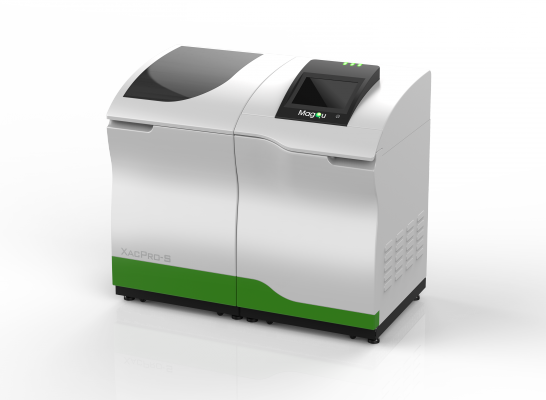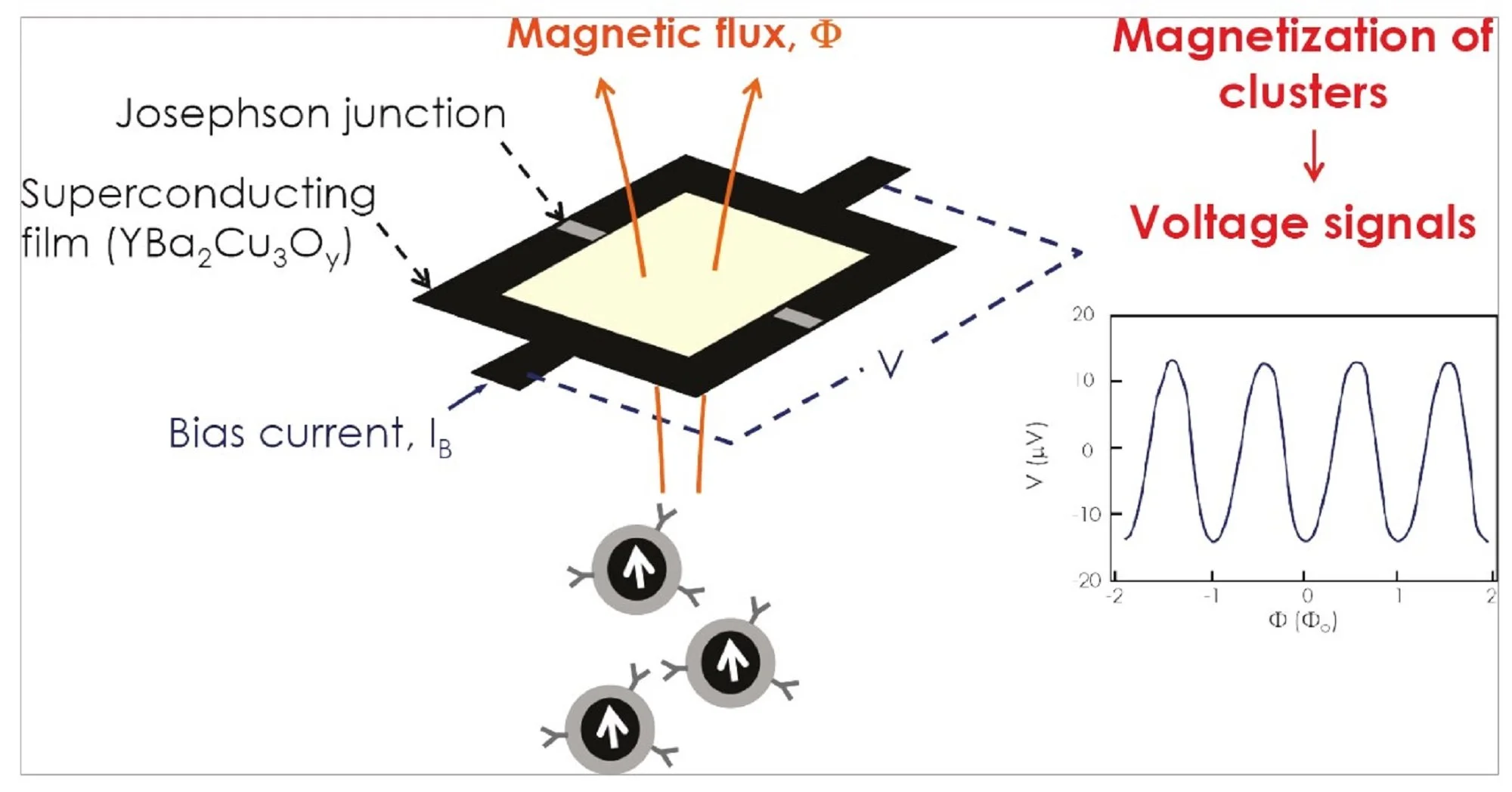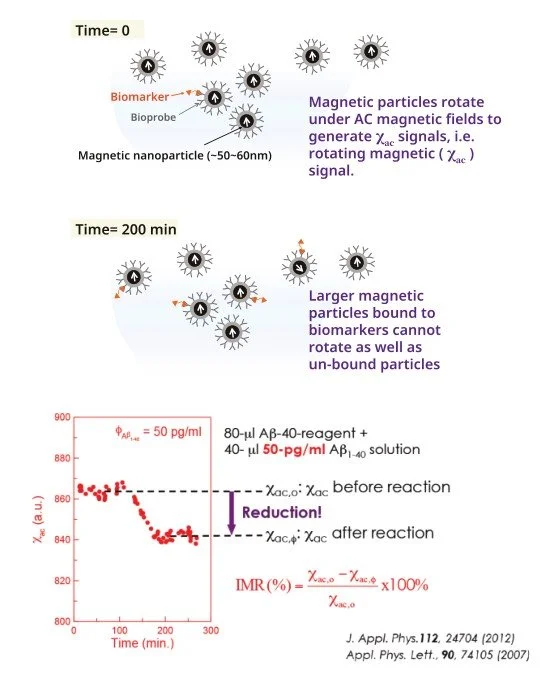Magnetic Immunoassay Analyzer
The magnetic immunoassay analyzer (Model: XacPro-S) launched by MagQu Co., Ltd. is used to measure the change in the ac magnetic susceptibility of a sample over time. If the sample is a mixture of a magnetic reagent and an object to be detected, it can be used to detect the concentration of bio-molecules in the object according to the change in the ac magnetic susceptibility of the mixture. XacPro-S is advantageous for bio-molecular assays in many ways, such as its operation is very simple, there is no need for users to calibrate concentration of the to-be-detected bio-molecules, it adopts CAA (Computer Automatic Analysis) with high accuracy and sensitivity and can detect low-concentration bio-molecules. XacPro-S can be applied to not only research, but also to clinical diagnosis and field trials.
To-be-detected bio-molecules mentioned above include protein, cytohormone, virus, nuclei acids , bacteria, even small molecular compounds. XacPro-S can help you to establish standard detection curves for new kinds of bio-molecules to be detected, further to measure content of the bio-molecules in the samples. It is expected that XacPro-S can be applied in the fields of in-vitro quantitative detection including agriculture, forest, fishing, stockbreeding, food and human body.
Features
XacPro-S
HTS SQUID-based Immuno-analyzer
Ultra sensitivity
Low interference
Easy to develop and use
Used with IMR reagent
Specifications
Sensor: Superconducting Quantum interference Device (SQUID)
Hands on time: Startup time <20 minutes
Sample volume: 5 hours with 36 channels (32 testing samplesper tubes)
Use application: In vitro diagnostic
Easy to develop: ImmunoMagnetic Reduction (IMR)
Order information: Magnetic Immunoassay Analyzer(XacPro-S361) Size: 161 x 91 x 138 cm
ImmunoMagnetic Reduction (IMR)
SQUID Is a very sensitive magnetometer that contains Josephson junctions. It is used to measure extremely subtle magnetic fields as low as 10 -14 T (Magnetic field of heart : 10 -10 ; Magnetic field of brain: 10 -13 )
CORE TECHNOLOGY
ImmunoMagnetic Reduction
Homogeneous Single-Antibody Assay
Description
The magnetic immunoassay analyzer (Model: XacPro-S) launched by MagQu Co., Ltd. is used to measure the change in the ac magnetic susceptibility of a sample over time. If the sample is a mixture of a magnetic reagent and an object to be detected, it can be used to detect the concentration of bio-molecules in the object according to the change in the ac magnetic susceptibility of the mixture. XacPro-S is advantageous for bio-molecular assays in many ways, such as its operation is very simple, there is no need for users to calibrate concentration of the to-be-detected bio-molecules, it adopts CAA (Computer Automatic Analysis) with high accuracy and sensitivity and can detect low-concentration bio-molecules. XacPro-S can be applied to not only research, but also to clinical diagnosis and field trials.
To-be-detected bio-molecules mentioned above include protein, cytohormone, virus, nuclei acids , bacteria, even small molecular compounds. XacPro-S can help you to establish standard detection curves for new kinds of bio-molecules to be detected, further to measure content of the bio-molecules in the samples. It is expected that XacPro-S can be applied in the fields of in-vitro quantitative detection including agriculture, forest, fishing, stockbreeding, food and human body..
SELECTED REFERENCES
Cancer
1. Wei PL, et. al., Validation of Assaying Carcinoembryonic Antigen in Human Serum by Using Immunomagnetic Reduction. Sci Rep. 2018 Jul 3;8(1):10002.
2. Chieh JJ, et. al. Immunomagnetic Reduction Assay on Des-Gamma-Carboxy Prothrombin for Screening of Hepatocellular Carcinoma. IEEE Trans Biomed Eng. 2016 Aug;63(8):1681-6.
3. Yang CC, et. al., Development of antibody functionalized magnetic nanoparticles for the immunoassay of carcinoembryonic antigen: a feasibility study for clinical
use. J Nanobiotechnology. 2014 Nov 26;12:44.
4. Huang KW, et. al., Exploration of the relationship between the tumor burden and the concentration of vascular endothelial growth factor in liver-cancer-bearing
animals using immunomagnetic reduction assay. J Biomed Nanotechnol. 2011 Aug;7(4):535-41.
Depression
1. Tang SC, et. al., Plasma β-Amyloids and Tau Proteins in Patients with Vascular Cognitive Impairment. Neuromolecular Med. 2018 Sep 21.
Stroke
1. Tang SC, et. al., Plasma β-Amyloids and Tau Proteins in Patients with Vascular Cognitive Impairment. Neuromolecular Med. 2018 Sep 21.
Virus and Infection
1. Liu BH, et. al., A Novel Detection Platform for Shrimp White Spot Syndrome Virus Using an ICP11-Dependent Immunomagnetic Reduction (IMR) Assay. PLoS One. 2015 Sep 18;10(9):e0138207.
2. Chang CH, et. al., Use of immunomagnetic reduction for C-reactive protein assay in clinical samples. Int J Nanomedicine. 2012;7:4335-40.
3. Yang SY, et. al., A novel quantitative immunomagnetic reduction assay for Nervous necrosis virus. J Vet Diagn Invest. 2012 Sep;24(5):911-7.
4. Lu MW, et. al., Immunomagnetic reduction assay for nervous necrosis virus extracted from groupers. J Virol Methods. 2012 Apr;181(1):68-72.
5. Yang SY, et. al., Ultra-highly sensitive and wash-free bio-detection of H5N1 virus by immunomagnetic reduction assays. J Virol Methods. 2008 Nov;153(2):250-2.
IMR Review & methodology
1. Chieh JJ, et. al., Eight-Channel AC Magnetosusceptometer of Magnetic Nanoparti-cles for High-Throughput and Ultra-High-Sensitivity Immunoassay. Sensors (Basel).2018 Mar 30;18(4). pii: E1043.
2. Lue LF, et. al., Amyloid Beta and Tau as Alzheimer's Disease Blood Biomarkers:Promise From New Technologies. Neurol Ther. 2017 Jul;6(Suppl1):25-36... Yang SY, et. al., Experimental study on low-detection limit for immunomagnetic reduction assays by manipulating reagent entities. IEEE Trans Nanobioscience. 2013 Jun;12(2):65-8.
Reproduction
1. Wong CH, et. al., Bio-functionalized magnetic nanoparticles for the immunoassay of fetal fibronectin: a feasibility study for the prediction of preterm birth. Sci Rep. 2017 Feb 15;7:42461.
2. Chen CY, et. al., Quantitative analysis of total β-subunit of human chorionic gonadotropin concentration in urine by immunomagnetic reduction to assist in the diagnosis of ectopic pregnancy. Int JNanomedicine. 2015 Mar 30;10:2475-83.
3. Chen CY, et. al., Clinical application of immunomagnetic reductionfor quantitative measurement of insulin-like growth factor binding protein-1 in the prediction of pregnant women with preterm premature rupture of membranes. Clin Chim Acta. 2015 Jan 1;438:337-41.
4. Huang KW, et. al., Feasibility studies for assaying alpha-fetoprotein using antibody-activated magnetic nanoparticles. Int J Nanomedi- cine. 2012;7:1991-6.
5. Chieh JJ, et. al., In vivo screening of hepatocellular carcinoma using AC susceptibility of anti-alpha fetoprotein-activated magnetic nanoparticles. PLoS One. 2012;7(10):e46756.
Alzheimer's disease and Parkinson’s disease
1. Fan LY, et. al., The Relation Between Brain Amyloid Deposition, Cortical Atrophy, and Plasma Biomarkers in Amnesic Mild Cognitive Impairment and Alzheimer's Disease. Front Aging Neurosci. 2018 Jun 18;10:175.
2. Lin CH, et. al., Plasma Biomarkers Differentiate Parkinson's Disease From Atypical Parkinsonism Syndromes. Front Aging Neurosci. 2018 Apr 27;10:123.
3. Teunissen CE, et. al., Plasma Amyloid-β (Aβ42) Correlates with Cerebrospinal Fluid Aβ42 in Alzheimer's Disease. J Alzheimers Dis.2018;62(4):1857-1863.
4. Yang CC, et. al., Assay of Plasma Phosphorylated Tau Protein (Threonine 181) and Total Tau Protein in Early-Stage Alzheimer's Disease. J Alzheimers Dis. 2018;61(4):1323-1332.
5. Lue LF, et. al., Plasma Levels of Aβ42 and Tau Identified Probable Alzheimer's Dementia: Findings in Two Cohorts. Front Aging Neurosci. 2017 Jul 24;9:226
6. Lin CH, et. al., Plasma α-synuclein predicts cognitive decline in Parkinson's disease. J Neurol Neurosurg Psychiatry. 2017 Oct;88(10):818-824.
7. Lee NC, et. al., Blood Beta-Amyloid and Tau in Down Syndrome: A Comparison with Alzheimer's Disease. Front Aging Neurosci. 2017 Jan 17;8:316.
8. Tzen KY, et. al., Plasma Aβ but not tau is related to brain PiB retention in early Alzheimer's disease. ACS Chem Neurosci. 2014 Sep 17;5(9):830-6.
9. Chiu MJ, et. al., Plasma tau as a window to the brain-negative associa-tions with brain volume and memory function in mild cognitive impairment and early Alzheimer's disease. Hum Brain Mapp. 2014 Jul;35(7):3132-42.
10. Chiu MJ, et. al., Combined plasma biomarkers for diagnosing mild cognition impairment and Alzheimer's disease. ACS Chem Neurosci. 2013 Dec18;4(12):1530-6.
Applications
Quantification of Alzheimer’s disease biomarkers in blood
Quantitative detection for infectious viruses, e.g. H5N1
Identification of single-nucleotide polymorphism (SNP) in genomic DNA
Probing of protein-protein/protein-polysaccharide interaction
Quantitative detection for ultra-low-concentration bio-molecules, e.g. Alzheimer’s disease biomarkers in blood






